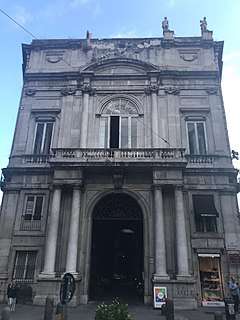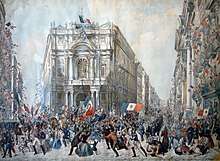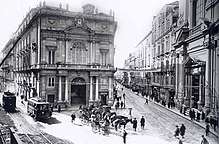Palazzo Doria d'Angri
The Palazzo Doria d’Angri is an historic building and monument in Naples in southern Italy located in Piazza 7 Settembre in the corner with the busy Via Toledo and Via Monteoliveto.
| Palazzo Doria d'Angri | |
|---|---|
 The main façade on Piazza 7 Settembre | |
| General information | |
| Status | Residential |
| Architectural style | Neoclassical |
| Location | Naples, Italy |
| Address | Piazza 7 Settembre, 28 |
| Construction started | 1760 |
| Completed | 1778 |
| Client | Family Doria D'Angri |
| Design and construction | |
| Architect |
Mario Gioffredo Carlo Vanvitelli |
History
The building was built on commission of prince Marcantonio Doria on the site of two previous houses of the 1500s. In 1760 the prince died, and the implementation of the Family Palace passed to his son Giovanni Carlo who entrusted the old Luigi Vanvitelli. After the death of Vanvitelli, in 1773, the plans passed before to Ferdinando Fuga, after to Mario Gioffredo and lastly to Carlo Vanvitelli, son of Luigi.

In 1860 the palace became famous because on 7th September from the main balcony Giuseppe Garibaldi announced the annexation of the Kingdom of the Two Sicilies into the Kingdom of Italy.
In 1940 the collection of Marcantonio Doria kept in the palace, which included also a Rubens' painting and the Caravaggio's "Martirio di Sant'Orsola", was sold in auction. During the World War II the building suffred some damages, especially on the top side of the façade, losing six of the eight sculptures which beautified the upper edge and the nobilty crest of the Doria's Family located above the main window of the façade.

Notes
Coordinates: 40°50′49″N 14°14′59″E / 40.846870°N 14.249611°E